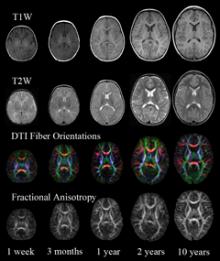Main Area of Focus

The NIH MRI Study of Normal Brain Development study collects MRI scans and correlated behavioral data from ~ 500 healthy, typically developing children, from newborn to late adolescence. Imaging modalities include structural MRI, spectroscopy and diffusion tensor imaging. The study will improve our understanding of brain development, provide a control database for studies of childhood psychiatric, developmental and neurological disorders, and may lead to new imaging tools.
Background
In order to provide a resource for the scientific community, this longitudinal MRI-based neuroimaging study enrolled more than 550 healthy, psychiatrically normal children and adolescents, ages newborn to 18 years, and studied them at three or more timepoints over seven years (oldest participants age 22 at the last timepoint). The resulting dataset provides a platform for studying healthy brain development and serves as a reference for identifying deviations associated with childhood brain disorders.
The core imaging modality was structural MRI. Ancillary modalities included diffusion tensor imaging (DTI) and proton MR spectroscopy. A comprehensive battery of clinical/behavioral data was also collected at three or more timepoints.
The study was supported by four NIH institutes using contracts. The NIH Blueprint provided supplemental funds for expanding the DTI portion of the study. Using Blueprint funds, Dr. Carlo Pierpaoli at NICHD has implemented a higher-resolution DTI protocol and developed DTI image analysis tools, called TORTOISE. The data and tools are freely available to qualified researchers through the NIH Pediatric MRI Data Repository.
The Montreal Neurological Institute at McGill University served as the Data Coordinating Center for the NIH MRI Study of Normal Brain Development
Contacts
Judith Rumsey, Ph.D., Clinical Neuroscience Research Branch
NIMH
301-443-9264
Related Resources
